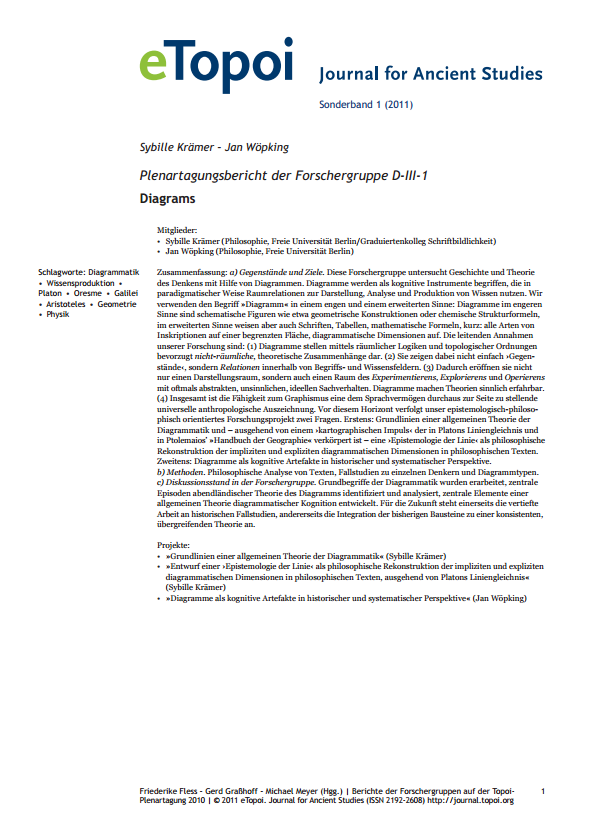Diagrams
(a) Topics and Goals. The Junior Research Group “Place, Space and Motion” investigates the role of spatial concepts in physical theories in the millennium from Plato (4th century BCE) through Philoponus and Simplicius (6th century CE). In particular, we examine the explicit theoretical views of ancient physicists and philosophers concerning space, the spatial features of bodies, and the existence of isomorphisms among space, change, and time. Projects are devoted to issues in Plato’s Timaeus and Aristotle’s Physics, and to the interwoven reception of these texts in Middle Platonism and Late Platonism. We trace the evolving answers given to such central questions as whether space is metaphysically basic or is rather dependent upon bodies or even non-spatial entities (such as souls); the possibility of empty space; the causal role of space in nature; how spatial structures make certain kinds of change possible or necessary. The group aims to produce a series of essays and commentaries examining key texts of Plato and Aristotle and tracing the reception and transformation of their views in Middle- and Late Platonism. (b) Methods. The group engages in close reading and interpretation of ancient texts, with the aim of constructing a history of engagement with the questions indicated above. The main areas of expertise brought to bear on the relevant texts lie in classical philology, history of ideas, history of science, and systematic philosophy. In a weekly research seminar, individual research projects and results are presented in detail and discussed in the light of these varied disciplines and skill sets. (c) State of Discussion. Relevant texts are interpreted both internally and in the light of their relationships with earlier sources and later readings. In this way a narrative is emerging of development and interrelationship among ancient theories of space – a narrative with some shape and coherence, but without the suppression of details and uncertainties. The group is also beginning to pay more attention to epistemological issues, concerning the sources of theoretical knowledge about space, and the evolving standards of argument, justification, and presentation of such knowledge.
a) Gegenstände und Ziele. Diese Forschergruppe untersucht Geschichte und Theorie des Denkens mit Hilfe von Diagrammen. Diagramme werden als kognitive Instrumente begriffen, die in paradigmatischer Weise Raumrelationen zur Darstellung, Analyse und Produktion von Wissen nutzen. Wir verwenden den Begriff “Diagramm” in einem engen und einem erweiterten Sinne: Diagramme im engeren Sinne sind schematische Figuren wie etwa geometrische Konstruktionen oder chemische Strukturformeln, im erweiterten Sinne weisen aber auch Schriften, Tabellen, mathematische Formeln, kurz: alle Arten von Inskriptionen auf einer begrenzten Fläche, diagrammatische Dimensionen auf. Die leitenden Annahmen unserer Forschung sind: (1) Diagramme stellen mittels räumlicher Logiken und topologischer Ordnungen bevorzugt nicht-räumliche, theoretische Zusammenhänge dar. (2) Sie zeigen dabei nicht einfach “Gegenstände”, sondern Relationen innerhalb von Begriffs- und Wissensfeldern. (3) Dadurch eröffnen sie nicht nur einen Darstellungsraum, sondern auch einen Raum des Experimentierens, Explorierens und Operierens mit oftmals abstrakten, unsinnlichen, ideellen Sachverhalten. Diagramme machen Theorien sinnlich erfahrbar. (4) Insgesamt ist die Fähigkeit zum Graphismus eine dem Sprachvermögen durchaus zur Seite zu stellende universelle anthropologische Auszeichnung. Vor diesem Horizont verfolgt unser epistemologisch-philosophisch orientiertes Forschungsprojekt zwei Fragen. Erstens: Grundlinien einer allgemeinen Theorie der Diagrammatik und – ausgehend von einem “kartographischen Impuls” der in Platons Liniengleichnis und in Ptolemaios’ “Handbuch der Geographie” verkörpert ist – eine “Epistemologie der Linie” als philosophische Rekonstruktion der impliziten und expliziten diagrammatischen Dimensionen in philosophischen Texten. Zweitens: Diagramme als kognitive Artefakte in historischer und systematischer Perspektive. b) Methoden. Philosophische Analyse von Texten, Fallstudien zu einzelnen Denkern und Diagrammtypen. c) Diskussionsstand in der Forschergruppe. Grundbegriffe der Diagrammatik wurden erarbeitet, zentrale Episoden abendländischer Theorie des Diagramms identifiziert und analysiert, zentrale Elemente einer allgemeinen Theorie diagrammatischer Kognition entwickelt. Für die Zukunft steht einerseits die vertiefte Arbeit an historischen Fallstudien, andererseits die Integration der bisherigen Bausteine zu einer konsistenten, übergreifenden Theorie an.

